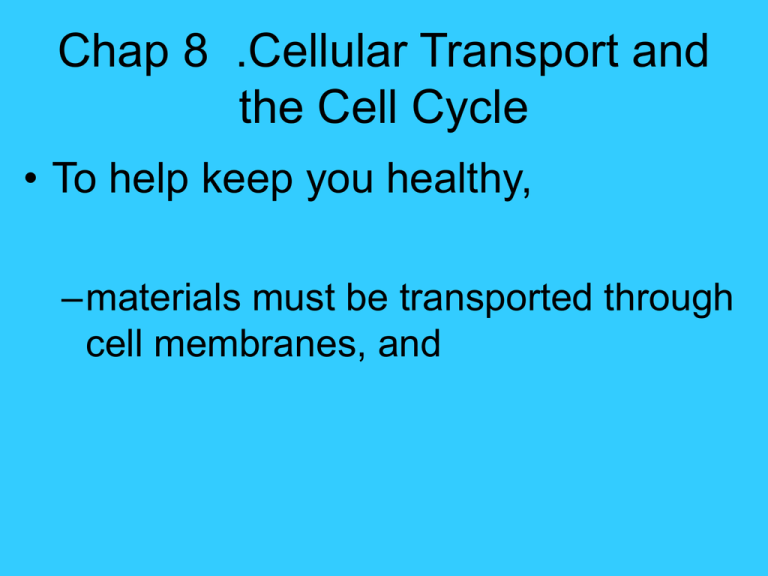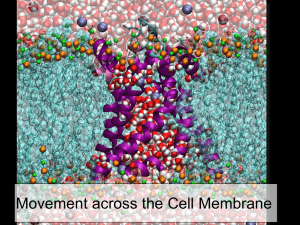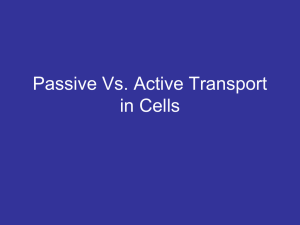Exocytosis
advertisement

Chap 8 .Cellular Transport and the Cell Cycle • To help keep you healthy, –materials must be transported through cell membranes, and CHAPTER OBJECTIVES • Be able to explain these processes : • diffusion, passive transport, active transport, endocytosis and exocytosis. • Be able to explain why these are important to living cells • Be able to predict the effect of a hypertonic, hypotonic or isotonic solution on a cell. • Be able to explain why cell size is limited • Be able to sequence the events of the cell cycle. • Be able to describe and illustrate the four stages of Mitosis • Be able to explain how the Cell Cycle is Regulated. • How are Cell Cycle Control and cancer related? Section 8.1 Cellular Transport 1. Osmosis 2. Passive Transport 3. Active transport 4.Endocytosis 5.Exocytosis Diffusion Fig. 5.8, p. 80 Osmosis •Diffusion of water molecules across a selectively permeable membrane Water in cells • In a cell, water always moves to balance concentration on both sides of the cell. • Helps maintain Homeostasis . • What affects osmosis? • Solids • solution:__________+ __________ • Concentration gradient: unequal distribution of ______ on both sides of a membrane. Tonicity: Comparing solute concentrations Isotonic solutions: equal Hypertonic –more Hypotonic - less Tonicity and Osmosis 2% sucrose water 10% sucrose 2% sucrose There is a concentration gradient here • . compartment 1 compartment 2 HYPOTONIC SOLUTION HYPERTONIC SOLUTION membrane permeable to water but not to solutes fluid volume increases In compartment 2 Fig. 5.23, p. 89 Osmotic Pressure • Water enters cell –swells • Exerts pressure on the cell membrane • How does a plant cell withstand this pressure? • Animal cell? WORK WITH YOUR SHOULDER PARTNER FOR THE NEXT 5-7 MIN TO ANSWER THE FOLLOWING 6 QUESTIONS. 1. What happens to cells (plant and animal) in a hypotonic solution? 2. Why does an animal cell burst? 3. What keeps a plant cell from bursting? 4. Why do plants wilt (hint, read p. 197 and 198) 5. What happens to cells (plant and animal) in a hypertonic solution? 6. What happens to cells (plant and animal) in an isotonic solution? Follow directions for the foldable on p. 195 • Using your text-p. 197, draw pictures in your foldable of animal and plant cells in • Isotonic solution • Hypotonic solution • Hypertonic solution • Describe what is happening in each. prepare a table in your notes Type of Transport Transport Protein Used? SIMPLE DIFFUSION FACILITATED DIFFUSION ACTIVE TRANSPORT ENDOCYTOSIS EXOCYTOSIS Direction of Movement Requires Energy Input From Cell? Classification of Transport (active/passive) Facilitated Duffusion prepare a table in your notes Type of Transport Transport Protein Used? Direction of Movement Requires Energy Input From Cell? Classification of Transport (active/passive) SIMPLE DIFFUSION no High to low conc no passive FACILITATED DIFFUSION Yes Channel or carrier High to low conc no passive ACTIVE TRANSPORT Yes, carrier (pump) Low to high conc Yes Yes ENDOCYTOSIS No Active Neither Both yes EXOCYTOSIS no both neither 2. Passive Transport NO ENERGY NEEDED; DIFFUSION DOWN CONC. GRADIENT. 2 TYPES: • 1. Simple Diffusion: through lipid bilayer: nonpolar (O2, CO2), water(small) • 2. Facilitated Diffusion: using a transport protein—2 kinds: 1. Channel Proteins 2. Carrier Proteins (change shape) Carrier Protein : Facilitated diffusion solute Active Transport •Solutes go against concentration gradient (from less conc. to more) •Requires Energy •Through a Carrier Protein (called a pump) Active Transport • 1. Sodium Potassium PumpEnables cells to conduct nerve impulses • 2. Proton Pumps—These are the key to cell metabolism— (mitochondria and chloroplasts) animation Transport of Large Particles: These both require energy. •1. Endocytosis- a cell surrounds and brings in particles, or even whole cells. 2. Exocytosis-The expulsion or secretion of materials from a cell. EXOCYTOSIS The vacuole formed moves inside the cell. Section 8.2 Cell Growth and Reproduction • Cell Size Limitations • Why can’t you be just one BIG CELL??? 1.Diffusion – Within the cell nutrients and waste move by __________ • Not so effiecient over long distances! More limitations… • 2. DNA – Cell can’t survive unless there is enough of it to support the protein needs. – WHAT DOES DNA HAVE TO DO WITH PROTEINS ANYWAY? Yet More Limitations!! • 3. Surface area to volume ratio. – As a cell’s size increases, the volume increases at a much faster rate than its surface area. 1 mm cube 2mm cube S.A 6x1x1= 6mm2 6 x 2x2= V. 1mm 3 4 mm cube Mitosis • A type of nuclear division. • The process by which 2 daughter cells are formed, each containing a complete set of chromosomes. 1. Prophase • Longest phase • Chromatin coils to form visible chromosomes • Nuclear envelope breaks apart • Nucleolus disappears • Centrioles (in animals) migrate to opposite sides • Spindle Forms; • Aster visible in animal cells. Sister chromatids become attached to spindle fibers at their centromere. Sister Chromatids line up at spindle equator. Metaphase Anaphase • Sister chromatids pulled apart Telophase • Chromosomes unwind—back into chromatin. • New nuclear envelopes form around each set of chromatin. • Cytoplasmic division CYTOKINESIS • Different in plants and animals • In Animals: a furrow forms and the cell pinches in 2 • In plants, a cell plate forms across the middle, them membranes, then cell walls. Results of Mitosis • 2 new cells with chromosomes that are identical to parent cell. • Function identically to the parent cell. Importance of Mitosis • Single-celled organisms: reproduce this way. • Multicellular organisms: – Enables formation of tissues and organs, and organ systems Section 8.3 CONTROL OF THE CELL CYCLE 2 types of proteins involved in control: 1. Controlled by cyclins ( a protein) 2. A type of enzyme activates the cyclin. Together, this activated cyclin regulates the cell cycle. Uncontrolled cell growth • Tumor – 1. Benign – 2. Malignant Cancer • • • • Malignant tumor Results from uncontrolled cell division Cell cycle controls not functioning normally. Results from changes in one or more genes involved in production of proteins involved in the cell cycle. • May metestasize: travel via blood to other parts of the body. Causes • Environmental • Genetic • Viral Infections (virus may damage genes) Cancer Prevention • A healthy diet • Fiber—reduce incidence of colon cancer • Fat moderation • Vitamins A,C,E, bets carotene (all antioxidants) • Minerals: calcium • Exercise Fluid-Mosaic Model Cell recognition protein ..\Unit 3\Interactive Animations.htm ..\unit 2 documents\animationsNa K pump.htm Example: Glucagon • In this role, glucagon is a Ligand Fig. 5.24, p. 89 Protein Hormone binds with surface receptor GLUCAGON-Why does it not just pass through the cell membrane? • Made of Protein—so it is • Unable to pass through lipid layer. • Binds with cell receptor, but does NOT enter cell. Gated Channel 2. Voltage-Gated: Respond so change in Electrical current :Sodium/Potassium- Nerve Impulse Transmission Concentration gradient low lipid bilayer . P energy input high DIFFUSION ACROSS LIPID BILAYER PASSIVE TRANSPORT facilitated diffusion ACTIVE TRANSPORT Lipid-soluble molecules and water molecules diffuse across Water-soluble molecules and ions diffuse through interior of transport proteins. No energy boost required. Specific solutes pumped across, through transport proteins against gradient; requires energy boost Fig. 5.25a, p. 91 Cell Membrane Semi-permeabl • Permeable to :Small molecules: H2O, O2, CO2, hydrophobic molecules, small lipids • Impermeable to : large polar molecules,ions K=, Na+, glucose, macromolecules, proteins, carbs., DNA Diffusion Movement of molecules from higher conc. to lower concentration until =










